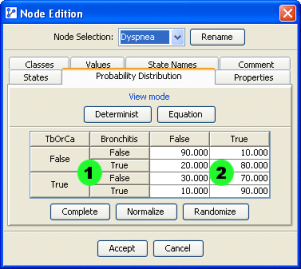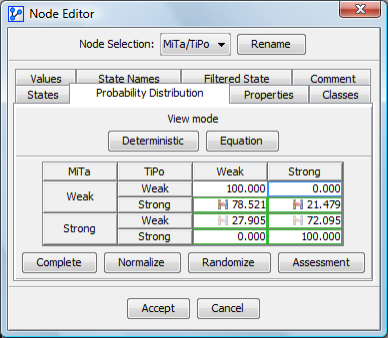Conditional Probability Tables
Whereas the arcs connecting the nodes constitute the qualitative part of the network by indicating the direct probabilistic dependences, conditional probability distributions represent the quantitative part (type and strength of the probabilistic relations). The most commonly used representation models to describe these distributions are the conditional probability tables.

The reading of a conditional probability table in BayesiaLab is carried out in the following way:
- zone1** corresponds to the value combinations of the parents of the node. Of course, this zone exists only if the node has at least one entering arc. When a node has parents, it is possible to change the order of the parents by dragging the name of the parents inside the header of the zone 1. When a parent is moved, the conditional probability table is reorganized to take the modification into account.
- zone2** corresponds to the probability distributions, conditionally to each case described by zone 1, or to the a priori probability distribution in the absence of entering arc. If the network has a database and the states of the node are not modified, a tool tip displays, for each probabilities, the number of corresponding cases in the database (taking into account the smoothingfactor**, if any) and the rep- resented percentage of the database.
Example
The interpretation of the first line of this table is thus:
the probability of having Dyspnea is 10% when TbOrCa is False and Bronchitis is False
Table Edition
The main problem with conditional probability tables is the exponential growth of the number of lines with respect to the number of parents. Their data acquisition can then quickly become a tedious task. When databases exist, it is possible to fill them automatically (learning of the parameters). It is also possible to use equations to describe more concisely the probability distributions.
The probability acquisition can also be alleviated by using the cut & paste facilities, inside the same table, between different tables or with external applications.
These tables also come with the classical cell selection tools, either by directly clicking on the cells, or by clicking on the line/column headers. Whereas a click on a header with the Ctrl key pressed allows making an OR with the previous selection, the same click with the Shift key makes an AND. A click with the Ctrl key on a cell allows selecting/unselecting the cell without changing the set of selected cells. This is then the way to edit a cell that belongs to a selection and to set this edit to all the other selected cells. A click on a cell with the Shift key pressed selects form the active cell to the pointed cell.
Probabilities can be copied and pasted to other tables or to external applications.
Complete
This operation consists in equally distributing the residual probability, defined as being equal to 100 - the sum of the probabilities already defined on the line. If there are blank cells, this residual probability is distributed on these cells. Otherwise, if the residual probability is positive, this operation works as the Normalization one over all the cells of the line.

Normalize
Depending on probability probabilities are reduced or augmented in such way that relative weight of each remains unchanged there at least a blank cell and if residual is positive this operation corresponds to the complete one.
Randomize
All the cells of the Conditional Probability Table, or just the selected cells, are randomly filled.
Assessment
When experts are associated with the network, a button Assessment is displayed and is activated when a cell is selected. The border of the cells with assessments becomes green and the icon displayed in the cell indicates how important is the disagreement between the experts for this cell.
